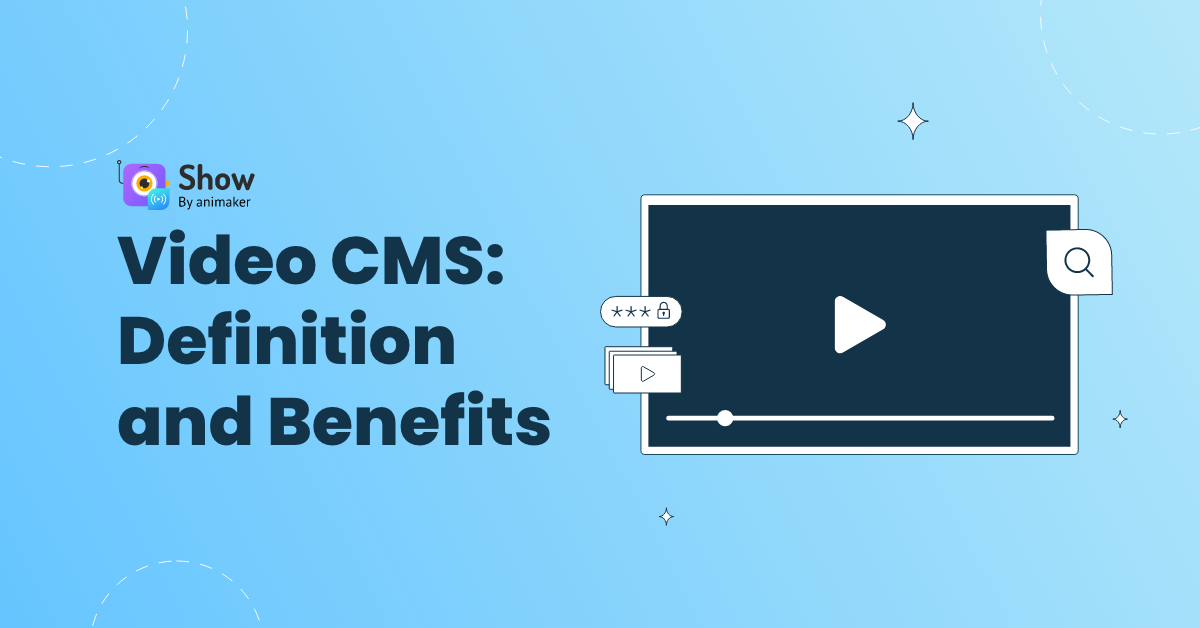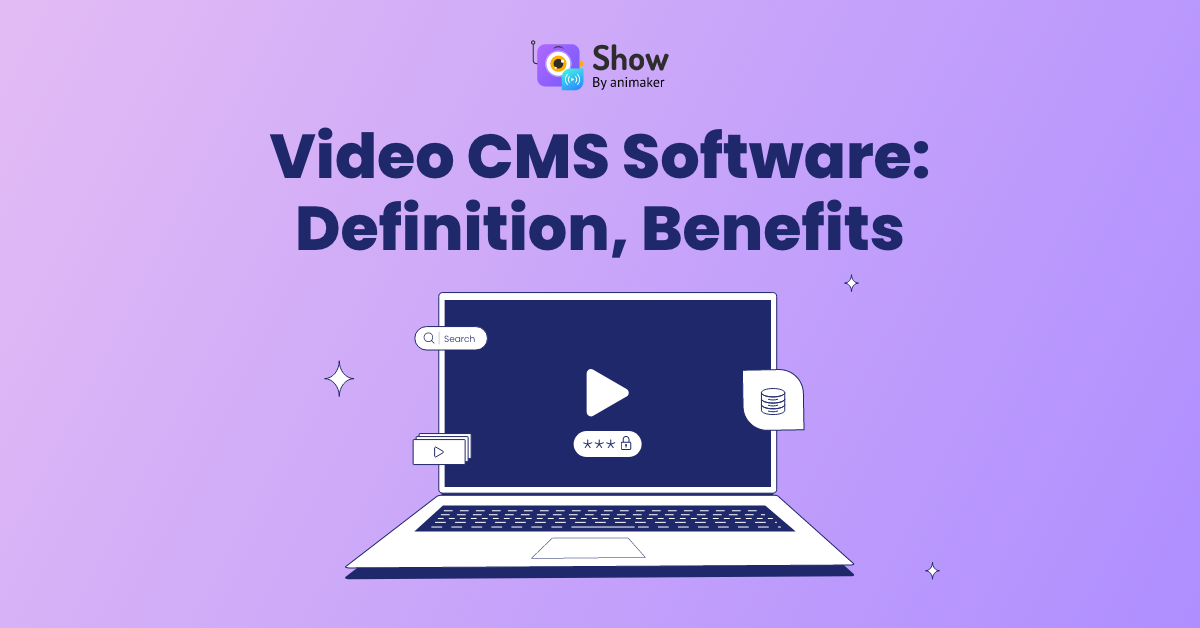Contents
How Does A Video CMS Software Work?
What Are the Benefits Of A Video CMS Software?
What Is A Video CMS & The Benefits of Using One
If you are a marketer in 2021, you must know about content management systems and their benefits. But with video content on the rise, are you aware of video CMS software and its plethora of benefits yet?
What is video CMS? Content management systems, abbreviated as CMS, have been becoming increasingly popular since the advent of the internet. This comes as no surprise since the consumption of digital content has only risen over the past years.
But with the establishment of YouTube, we are seeing a new era in the digital space where videos are dominating internet content. Findings by Hubspot have noted that videos started booming in 2016 and have only increased in popularity since then.
Video Content Management System Market Size, Share and Global Market Forecast to 2026
Obviously, considering the circumstances, every marketer who is trying to harness the power of videos is in desperate need of video CMS software. But if you are still having doubts about its importance in your marketing efforts, we are here to tell you about all the ways in which a video CMS is a must-have.
What is A Video CMS Software?
Unlike content pieces that exist in text form, videos are made up of large files that occupy a lot of space. They are also completely different from the traditional blog posts and images since they incorporate audio as well as a visual component.
A video CMS software is a software technology designed for the specific purpose of storing, organizing, and managing videos. Video CMS allows you to streamline your video creation, storage, organization, and distribution process for marketing purposes by creating a collected space for them.
A video CMS software is very much like other CMS such as WordPress and Shopify. However, there are a variety of reasons that set it apart. Having been designed specifically for videos, this type of CMS is definitely the superior choice for all your video content management needs.
How Does A Video CMS Software Work?
The best way to understand how a video CMS software works would be to look at one of the largest sources of video content out there that provide billions of hours of videos— YouTube.
While YouTube’s CMS is not available to every creator out there, the platform’s wild popularity makes it one of the most well-known names in the world of videos. Clearly, is it the best option for understanding anything related to video content?
As the second-largest search engine in the world, YouTube contains the most popular yet simple example of video CMS software.
The YouTube Studio Content Manager, available only to partners of the platform, acts as a broad database that contains all data and uploads related to the creator. Whether it is organizing your videos, keeping an eye on your assets, or managing video uploads without copyright violations— the CMS helps you with it all.
Every type of video CMS software out there works much in the same manner. They provide a platform where you can store, modify, sort, host, and organize your video files. These platforms are designed to support the data-heavy nature of video files and provide a smooth and easy-going experience for managing video content.
What Are the Benefits Of A Video CMS Software?
There is no doubt that video CMS software will be better for managing video content. After all, it is made for the purpose of managing videos only. But it is also important that we need to know the important factors for choosing the right video CMS software.
But if you are curious about the exact benefits that accompany using a video CMS software, here is some light shed on it:
1. Dedicated Storage for Large Files
This is the leading reason why video CMS is special. To put it simply, they are meant only for videos.
Video files are completely different from textual content like blog posts or even images like infographics. They combine audio and visual elements together and occupy a large chunk of space on a server.
In fact, according to Hubspot, the average video file of 5 minutes long will occupy 1000 times more space than a regular JPEG image of 15 KB. Definitely very data-heavy, right?
Considering how special video files are, they require a special CMS dedicated only towards managing them. Video CMS perfectly serves this purpose.
2. Smooth Streaming Experience
Large files occupy much more than space on the server. They consume more bandwidth too.
This means that with files as large as videos, your audience will experience more sluggishness in their browsing experience.
This does not even consider the fact that video files need to be saved in different formats so that they can readily be played on every type of device. Especially for mobile devices, choosing the right file format is important. After all, over half the global internet traffic is generated from them.
All this can really weigh down a CMS that has not been designed to accommodate large files. By using video CMS software, you can avoid the hassle of hampering your audience’s streaming experience.
3. Enhanced Privacy & Security
While videos are a mind-blowing way of marketing products and services, that is not all that they are used for. Videos are also a fabulous way of exchanging internal information or even training your employees.
In fact, did you know that findings by the SAVO group report that most employees forget 65% of their training material only a week after the training period? This percentage spikes to a dismal 90% just 3 months down the line!
With videos, employees retain information and training up to 83% more effectively. Clearly, videos help people retain information better.
But you would not be privy to such videos, right?
With video CMS software, you can store, organize, share, and stream videos internally without worrying about privacy and security. These systems do not just provide measures such as encryption for security; they also have a host of measures such as password protection for the sake of privacy.
4. Better Search & Organization
If you deal with a lot of videos, having an entire database with all the videos in one place might sound intimidating. But do not forget that video CMS software was designed just to help you deal with that!
These systems allow several measures so that you can search your database with ease. And no, it is much more than just searching for video files by name.
Video CMS has filters such as sorting by date, last modified, etc to make searching easier.
Even better? Such filters are also available in the video CMS simply for the sake of organizing your videos. Store videos under different categories in different folders and you will never face any issues tracking down a particular video again!
5. Video Specific Analytics
A video CMS software provides you with a range of analytics to measure the performance of your video content.
Image Source: YuJa.Com
Any successful marketer knows that analytics is no less than the Bible for them. You cannot just implement strategies and leave them at that.
You need to keep a check on them, evaluate them based on certain KPIs, identify gaps and problems, and improve them. Only then can you expect optimal results.
Videos are definitely no different at all.
If you want your video marketing efforts to pay off well, you need to use video CMS software. Such systems have in-built analytics and evaluation criteria that are perfect for optimizing your campaigns.
With the ability to access KPIs such as views, impressions, and clicks, a video CMS makes marketing with video content so much easier. Simply read, interpret, and optimize!
6. Variety of Integrations
One of the most underestimated benefits of video CMS software is that it can be extremely advanced!
A video CMS is much more than a slightly more complex form of an Excel sheet meant for video content. It is a living, breathing ecosystem that nurtures all marketing as well as other processes associated with video content to streamline your needs and provide a one-stop solution.
Due to this, many video CMS comes with advanced integrations consisting of artificial intelligence and data learning simply for the sake of providing you with all the services in one place!
In fact, some video CMS make your life so easy that you do not need to even acquaint yourself with the functioning and user interface of new software. They smoothly integrate into your existing CMS and bring all the benefits you need!
7. Batch Uploading
We have said this before but we will say this again— video files are large and extremely heavy! They occupy space and slow down websites unless the server is specifically designed for handling such large files.
So, can you imagine the hassle you will have to go through for uploading such files to a database?
Uploading a single video file would take you ages. Uploading them in batches would simply overload your system with the heavyweight and cause you even more frustration.
Video CMS is your savior here.
With their ability to manage and store large files, usually by including with the Cloud, they can provide you with greater ease. These systems know how to handle such files and allow batch uploading much easily.
Time is money and video CMS ensures that you do not lose out on this valuable currency as much as possible!
8. Complete Control
We know that you probably do not want to indulge in the hassle of adapting to or integrating a new CMS. After all, your existing CMS probably has enough plugins and integrations to support video content, right?
Absolutely wrong. These plugins and integrations only enhance your current CMS’s functionality.
Sure, they can make the video content management process slightly easier. But can they transform your CMS into a technology designed specifically for handling videos?
If you want complete control over your video content management processes, you need to switch to a video CMS. It is the only way you can ensure that you avail of maximum benefits with minimal hassle.
9. Video API Access
The modern-day market is competitive beyond belief. Every industry has existing businesses that act as big players, while also nurturing thousands of startups that pop up with the aspiration of making a name in the field.
When the modern consumer is being bombarded with ads and promotions in every sphere of life, personalization is the secret ingredient to persuasion. This stands true even for videos.
White labeling your video content tools means modifying their appearance and interface to incorporate your brand’s identity and voice. It can be as simple as the color of the video player or the presence of a logo. After all, these are the small touches that make your videos yours.
With video CMS software, you have access to video APIs due to which you can perform such personalizations. This might seem like a tiny benefit but do not underestimate its benefits.
Personalization has always been a game-changer and one of the major reasons why videos became so popular in the first place. In fact, 36% of consumers would prefer more personalized ads and promotions.
10. Video Monetization
Why should you restrict videos just as a way of marketing? You can also use them to earn some passive income for your business!
When videos are so popular that the video streaming marketing grew by 55% in 2020 itself, there should be no surprise that this content form has been monetized too. After all, it is only natural to capitalize on such a wildly popular type of content.
Whether it is as simple as streaming your videos on YouTube for its Monetization Program or using a hosting service with a built-in video paywall— monetizing your videos does not have to be difficult.
With an effective video CMS software, you can organize your videos, track the money they earn you, and analyze trends to make videos with maximum earning potential. Many paid video CMS also provide options such as Pay-per-View, Subscription Fee, and In-Stream Ad Earnings to monetize your content all on your own.
All these methods allow you to monetize your videos while also accomplishing your goals.
Frequently Asked Questions (FAQs)
Considering the tremendous rise in the popularity of video marketing, these tools are constantly on the rise. All marketers who invest in video marketing want results and video CMS software helps exactly with that.
For more information about the best video CMS software on the market, read ahead:
CMS Hub:
Offered by Hubspot, this video CMS software combines with the functionality of a video hosting platform to serve you with the purposes of both platforms.
The platform allows you to build a beautiful landing page with a prominent CTA button. It allows the white labeling of your player so that your audience receives a highly personalized experience.
Beginning at only $ 23/month, CMS Hub is definitely a good bargain for those who are just starting out with content writing.
Bright Cove:
Brightcove is another excellent video CMS software out there that makes the lives of its users easier. With a host of features and benefits that make it a much more advanced platform, it is best for strictly professional work.
However, an important issue to note with BrightCove is that it can be quite an expensive option. They do not have any packages listed on their website and you will have to call them up in order to get a quote.
Show by Animaker:
Show is the newest videos CMS software from the house of Animaker. It is not only just store your content but truly manage videos. It is the most flexible video CMS with some introducing features are to secure, share, track, brand, and optimize the videos.
From standard to 8K, you can choose the quality of videos you would like to share as well as enable the viewers to decide what quality they would prefer while watching your videos. Except this, the other best features are added logos, insights on viewers’ engagement, add interesting footers to videos to deepen the viewer experience, etc.
Panopto:
Founded in 2007, Panopto stands third in this list because of its amazing user interface that provides a smooth experience, great security that keeps your video content safe, and the use of video APIs for multi-channel deliverability.
Moreover, Panopto is also a very inexpensive option. It has a completely free Basic package and a Pro plan beginning from $ 14.99/month.
The biggest issue with Panopto is that it does not provide as many video customizations as the remaining recommendations. This means that you have fewer options to white label your video player and influence your audience.
A video CMS software and a video hosting platform serve very different purposes. However, this does not mean that they do not have any common features. In fact, many utilities of these two types of video marketing technologies greatly overlap.
Video CMS software is designed for the purpose of storing, organizing, and distributing video content to your audience. It helps you keep your video marketing efforts hassle-free by maintaining a sorted database of your videos with smooth and easy functionality.
On the other hand, a video hosting platform serves the purpose of distributing your video content to your target audience. It provides you with a smooth video player curated to store and stream large files such as videos in the right format and size on the corresponding device.
Both these technologies provide you with the option to store and sort your video content. However, while this is the primary function of a video CMS software, it is not the case for a video hosting platform.
Similarly, while some video CMS have the option of hosting and distributing videos, that is not necessarily their primary function.
Much in the same way a video CMS software is different from a video hosting platform, there are similarities yet differences between a video CMS software and a video streaming platform too.
A video streaming platform is nothing more than a very specific type of video hosting platform. This kind of platform allows its users to stream video content on a live basis. This means that the audience can witness the events right as they are happening.
Apart from the fact that a video streaming platform is used for live streams rather than pre-recorded videos, their functionality is exactly the same as video hosting platforms. They provide the large server space and bandwidth needed for a smooth video player that can stream large files such as videos without any hiccups.
This accommodation for large files is what makes a video streaming platform similar to a video CMS software. However, that does not change that the two technologies serve very different purposes and only have some overlaps in features.
The traditional video CMS software, much like all conventional content management platforms out there, is coupled. This means that it performs the dual function of both storing the video content as well as distributing it. This also makes it quite similar to video hosting/video streaming platforms.
A headless CMS software, on the other hand, focuses only on the back-end only. This means that it does not involve any of the functionalities related to presenting i.e. distributing the video content stored in it in any way. It is due to its lack of front-end functionality that this video CMS is called ‘headless’.
Thus, headless CMS software acts as a repository for depositing content and accessing it as needed. It does not have a built-in video player or any other form of the presentation layer. Instead, it relies on video APIs to connect with different types of devices to make the content accessible.
The most major benefit that sets a headless CMS software apart is its flexibility in terms of delivering the video content stored in it.
The conventional video CMS software has its means of content delivery set in stone. Usually, this is a video player built into the CMS that allows the audience to stream the video content stored.
A headless video CMS software, on the other hand, does not have an in-built video player. This makes it much more adaptable to any device or means of accessing the video content. It uses video APIs to become compatible with whatever output medium you choose, thus allowing greater multi-channel deliverability.
A video CMS software is a much more superior platform for educational purposes than an LMS when it comes to video-learning
Image Source: OEB Global
As the name suggests, a Learning Management System or LMS is software that allows you to not just deliver content but also learn through it. This means that rather than just passively consuming the content stored, the audience also interacts with it so that they can imbibe it better.
While an LMS has its own benefits such as greater interactivity leading to better engagement and attention, it is not the ideal choice for your video content. We have said this before and we will say it again— videos are made up of large, heavy files that take up a lot of space.
The average LMS, much like the average CMS, is not made to handle the large weight of videos. This makes it a very poor choice for your videos. Thus, if you are looking to store, manage, and distribute your video content, video CMS software will always be the best.
There are a number of important factors you need to consider before investing in video CMS software.
The 5 most important factors to consider are:
Pricing:
The very first factor that you must consider when investing in any tool is pricing. What is your budget for the video marketing efforts? What plan would be the most suitable for you?
Depending on how small or big your campaign is and how much budget has been allotted to it, you could be requiring anything from the most expensive option on the market to the free ones.
Purpose:
Yes, all video CMS is meant for storing, organizing, and sorting video content. However, your needs are much beyond just sorting through your video content.
You need to have video CMS software that supports the goals of your video marketing efforts. Will you only be doing live streams? Are you recording promotional videos for your product/service? Are your videos meant for your employees?
All these questions will give you a better understanding of your needs and help you make the right choice.
Content-Base Size:
You need to do a full audit of all the video content your business owns and which will be stored in the video CMS. You also need to consider future campaigns and all content you might make in relation to it.
This is because different packages of video CMS plans would have different storage capacities. Since videos are large files and can heavily weigh down your website if there is not enough space, you need to always make sure that you have ample storage space to prevent these issues.
Choose Your Video CMS Software With Care
Video marketing is one of the most trendy marketing practices in the industry today. Every marketer is hopping onto this train and the need for video CMS software is only increasing every day.
Despite this, most beginners in the world of video marketing do not realize the immense importance of this tool. They underestimate the benefits they will derive from using it and stubbornly stick to their conventional CMS, leading to various problems.
The ideal video CMS software can transform your video marketing efforts. It can reap you several times the amount of time, energy, and money you invest. Clearly, video CMS is the superior choice for every marketer out there.
So, are you convinced about investing in video CMS software yet? Your video marketing efforts will never be complete without this tool!



